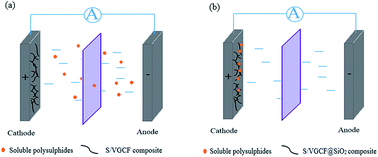Improving lithium–sulfur battery performance by using ternary hybrid cathode material
Abstract
Lithium–sulfur batteries are one attractive power source with a high energy density. But the practical use of a Li–S battery is still hindered by its rapid capacity decay owing to the polysulfide dissolution. In spite of much efforts in combining sulfur with porous carbon materials to suppress the dissolution of the polysulfide, relatively little attention has been paid to the role of silica in polysulfide adsorption. Herein, an efficient strategy is applied to limit the polysulfide dissolution by using a silica coated sulfur/vapor-grown carbon fiber composite (S/VGCF@SiO2) as the cathode material for the Li–S battery. The as-prepared S/VGCF@SiO2 composite exhibits better cycle stability and higher rate performance, compared with the bare S/VGCF composite. This improved performance is mainly due to the introduction of SiO2, which can effectively inhibit the “shuttle effect” of polysulfide.


 Please wait while we load your content...
Please wait while we load your content...